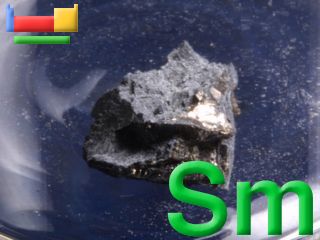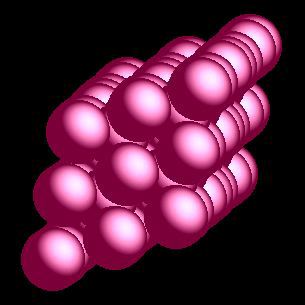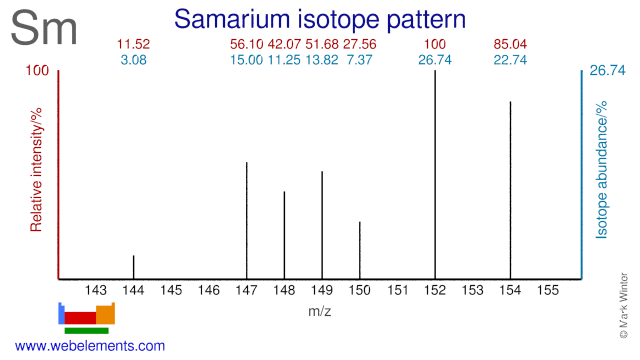Samarium - 62Sm: the essentials
- Name: samarium
- Symbol: Sm
- Atomic number: 62
- Relative atomic mass (Ar): 150.36 (2) g [see note g]
- Standard state: solid at 298 K
- Appearance: silvery white
- Classification: Metallic
- Group in periodic table:
- Group name: Lanthanoid
- Period in periodic table: 6 (lanthanoid)
- Block in periodic table: f
- Shell structure: 2.8.18.24.8.2
- CAS Registry: 7440-19-9
Samarium atoms have 62 electrons and the shell structure is 2.8.18.24.8.2. The ground state electronic configuration of neutral samarium is [Xe].4f6.6s2 and the term symbol of samarium is 7F0.
Samarium: description
Samarium has a bright silver lustre and is reasonably stable in air. It ignites in air at 150°C. It is a rare earth metal. It is found with other rare earth elements in minerals including monazite and bastnaesite and is used in electronics industries.

This sample is from The Elements Collection, an attractive and safely packaged collection of the 92 naturally occurring elements that is available for sale.
Samarium: physical properties
Density of solid: 7353 kg m-3
Molar volume: 19.98 cm3
Thermal conductivity: 13 W m‑1 K‑1
Samarium: heat properties
Melting point: 1345 [1072 °C (1962 °F)] K
Boiling point: 2076 [1803 °C (3277 °F)] K
Enthalpy of fusion: 20.5 kJ mol-1
Samarium: atom sizes
Atomic radius (empirical): 185 pm
Molecular single bond covalent radius: 172 (coordination number 3) ppm
van der Waals radius: 287 ppm
Samarium: electronegativities
Pauling electronegativity: 1.17 (Pauling units)
Allred Rochow electronegativity: 1.07 (Pauling units)
Mulliken-Jaffe electronegativity: (no data)
Samarium: orbital properties
First ionisation energy: 544.54 kJ mol‑1
Second ionisation energy: 1068.9 kJ mol‑1
Third ionisation energy: 2270 kJ mol‑1
Samarium: abundances
Universe: 5 ppb by weight
Crustal rocks: 6000 ppb by weight
Human: (no data) ppb by weight
Samarium: crystal structure

Samarium: biological data
Human abundance by weight: (no data) ppb by weight
Samarium has no biological role but is said to stimulate the metabolism.
Samarium: uses
Samarium: reactions
Reactions of samarium as the element with air, water, halogens, acids, and bases where known.
Samarium: binary compounds
Binary compounds with halogens (known as halides), oxygen (known as oxides), hydrogen (known as hydrides), and other compounds of samarium where known.
Samarium: compound properties
Bond strengths; lattice energies of samarium halides, hydrides, oxides (where known); and reduction potentials where known.
Samarium: history
Samarium was discovered by Paul Emile Lecoq de Boisbaudran in 1879 at France. Origin of name: named after "Samarskite" (a mineral).Samarium: isotopes

Samarium isotopes are used in various applications. Sm-144 is used for the production of the therapeutic radioisotope Sm-145. Sm-147 has been bombarded with Ca-40 to produce the short-lived radioisotopes Pb-182. Sm-148 has been used to study the giant monopole resonance while Sm-149 has been used in a filter for polarizing thermal neutrons. Sm-152 is used for the production of the radioisotope Sm-153 which is used for bone pain palliation. Finally, Sm-154 has been used to study the excited states of Sm-153.
Samarium: isolation
Isolation: samarium metal is available commercially so it is not normally necessary to make it in the laboratory, which is just as well as it is difficult to isolate as the pure metal. This is largely because of the way it is found in nature. The lanthanoids are found in nature in a number of minerals. The most important are xenotime, monazite, and bastnaesite. The first two are orthophosphate minerals LnPO4 (Ln deonotes a mixture of all the lanthanoids except promethium which is vanishingly rare) and the third is a fluoride carbonate LnCO3F. Lanthanoids with even atomic numbers are more common. The most comon lanthanoids in these minerals are, in order, cerium, lanthanum, neodymium, and praseodymium. Monazite also contains thorium and ytrrium which makes handling difficult since thorium and its decomposition products are radioactive.
For many purposes it is not particularly necessary to separate the metals, but if separation into individual metals is required, the process is complex. Initially, the metals are extracted as salts from the ores by extraction with sulphuric acid (H2SO4), hydrochloric acid (HCl), and sodium hydroxide (NaOH). Modern purification techniques for these lanthanoid salt mixtures are ingenious and involve selective complexation techniques, solvent extractions, and ion exchange chromatography.
Pure samarium is available through the electrolysis of a mixture of molten SmCl3 and NaCl (or CaCl2) in a graphite cell which acts as cathode using graphite as anode. The other product is chlorine gas.
